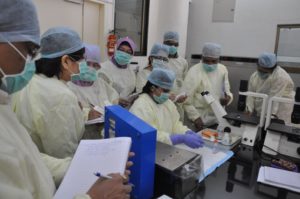The Global Polio Laboratory Network

Effective polio surveillance requires virologists, epidemiologists, clinicians and national immunization programme staff, backed up by a global network of laboratories.
The Global Polio Laboratory Network (GPLN) was established in 1990 by WHO and national governments. Its primary responsibility is to distinguish poliovirus as a cause of acute flaccid paralysis (AFP) from AFP caused by other diseases.
The GPLN consists of 146 WHO accredited polio laboratories, in 92 countries across the six WHO regions of the world.
National, regional and global specialized polio laboratories follow WHO-recommended procedures for detecting and characterizing polioviruses from stool and sewage samples collected from AFP cases and the environment, respectively.
The laboratories follow standardized protocols to (i) isolate poliovirus, (ii) identify wild poliovirus (WPV) or screen for Sabin (vaccine) poliovirus and vaccine-derived poliovirus (VDPV), and (iii) conduct genomic sequencing. Sequencing results help monitor how poliovirus is spreading by comparing the nucleotide sequences of poliovirus isolates.
The accuracy and quality of testing at GPLN member laboratories is monitored through an annual accreditation programme that includes onsite reviews of work practices, performance and proficiency testing.
The GPLN processes over 220 000 stool samples from AFP cases (and their contacts), and more than 8 000 sewage samples per year. In addition to surveillance, the GPLN carries out a research agenda aimed at improving laboratory diagnostics.
The GPLN meets every year to develop recommendations for improving performance and coordination and determine the research and resource needs of the network laboratories.







